MKT01760 Tourism Planning: Critique & Comparison of Discussion Papers
VerifiedAdded on 2023/06/10
|8
|1833
|404
Report
AI Summary
This report provides a critical evaluation and comparison of two discussion papers – the National Heritage Tourism Summit Discussion Paper and the Sustainable Food and Wine Project Discussion Paper – to depict their role in the policy planning cycle within the tourism industry. The analysis includes the current scenarios, opportunities, and challenges addressed in each paper. It also contrasts their approaches, such as the national focus of the heritage tourism paper versus the regional focus of the food and wine project. The report concludes by reflecting on the importance of policy planning and consultative approaches in the tourism sector, emphasizing the value of discussion papers in gathering stakeholder feedback. Desklib offers a wide array of similar solved assignments and study resources for students.
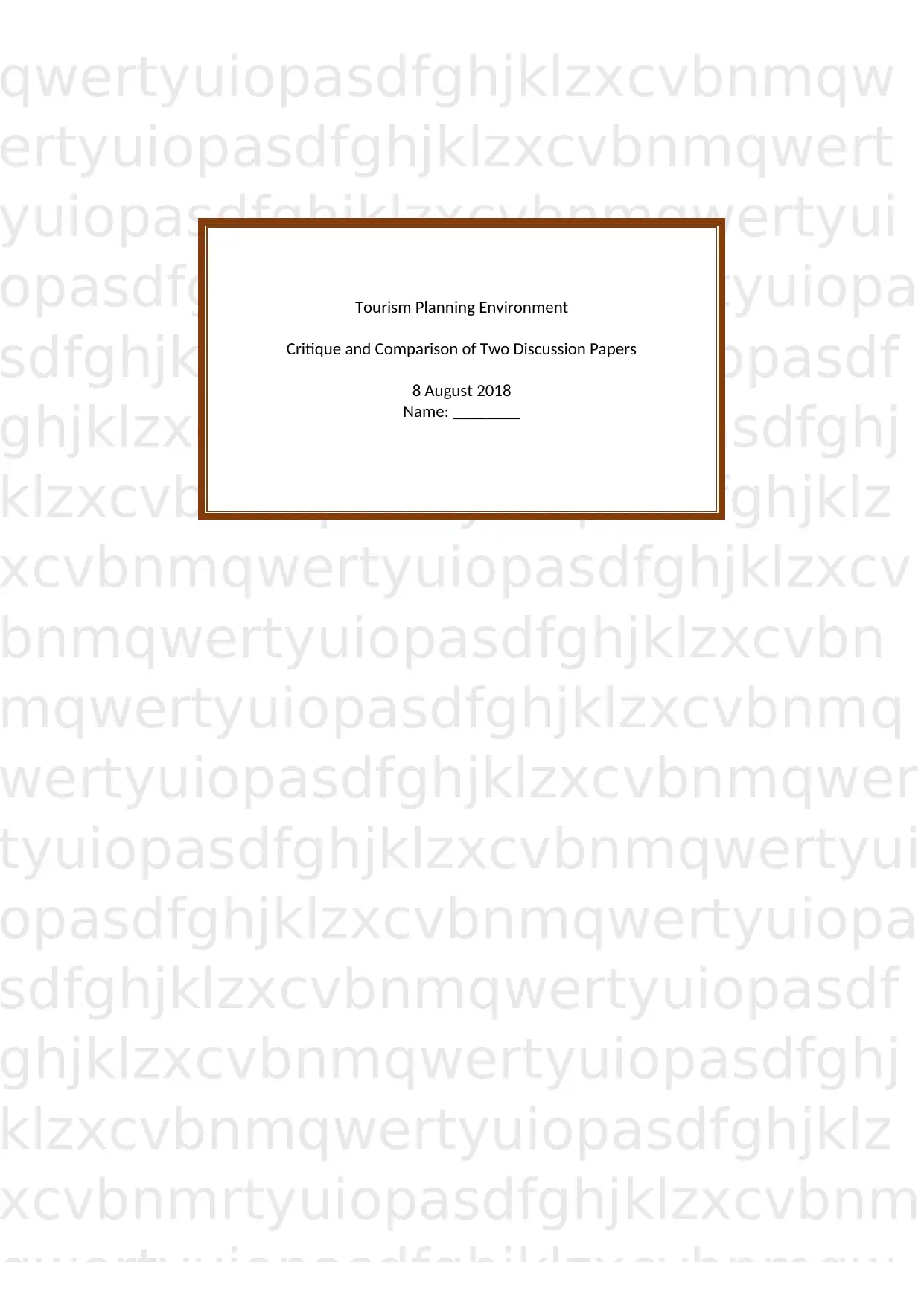
qwertyuiopasdfghjklzxcvbnmqw
ertyuiopasdfghjklzxcvbnmqwert
yuiopasdfghjklzxcvbnmqwertyui
opasdfghjklzxcvbnmqwertyuiopa
sdfghjklzxcvbnmqwertyuiopasdf
ghjklzxcvbnmqwertyuiopasdfghj
klzxcvbnmqwertyuiopasdfghjklz
xcvbnmqwertyuiopasdfghjklzxcv
bnmqwertyuiopasdfghjklzxcvbn
mqwertyuiopasdfghjklzxcvbnmq
wertyuiopasdfghjklzxcvbnmqwer
tyuiopasdfghjklzxcvbnmqwertyui
opasdfghjklzxcvbnmqwertyuiopa
sdfghjklzxcvbnmqwertyuiopasdf
ghjklzxcvbnmqwertyuiopasdfghj
klzxcvbnmqwertyuiopasdfghjklz
xcvbnmrtyuiopasdfghjklzxcvbnm
qwertyuiopasdfghjklzxcvbnmqw
Tourism Planning Environment
Critique and Comparison of Two Discussion Papers
8 August 2018
Name: ________
ertyuiopasdfghjklzxcvbnmqwert
yuiopasdfghjklzxcvbnmqwertyui
opasdfghjklzxcvbnmqwertyuiopa
sdfghjklzxcvbnmqwertyuiopasdf
ghjklzxcvbnmqwertyuiopasdfghj
klzxcvbnmqwertyuiopasdfghjklz
xcvbnmqwertyuiopasdfghjklzxcv
bnmqwertyuiopasdfghjklzxcvbn
mqwertyuiopasdfghjklzxcvbnmq
wertyuiopasdfghjklzxcvbnmqwer
tyuiopasdfghjklzxcvbnmqwertyui
opasdfghjklzxcvbnmqwertyuiopa
sdfghjklzxcvbnmqwertyuiopasdf
ghjklzxcvbnmqwertyuiopasdfghj
klzxcvbnmqwertyuiopasdfghjklz
xcvbnmrtyuiopasdfghjklzxcvbnm
qwertyuiopasdfghjklzxcvbnmqw
Tourism Planning Environment
Critique and Comparison of Two Discussion Papers
8 August 2018
Name: ________
Paraphrase This Document
Need a fresh take? Get an instant paraphrase of this document with our AI Paraphraser
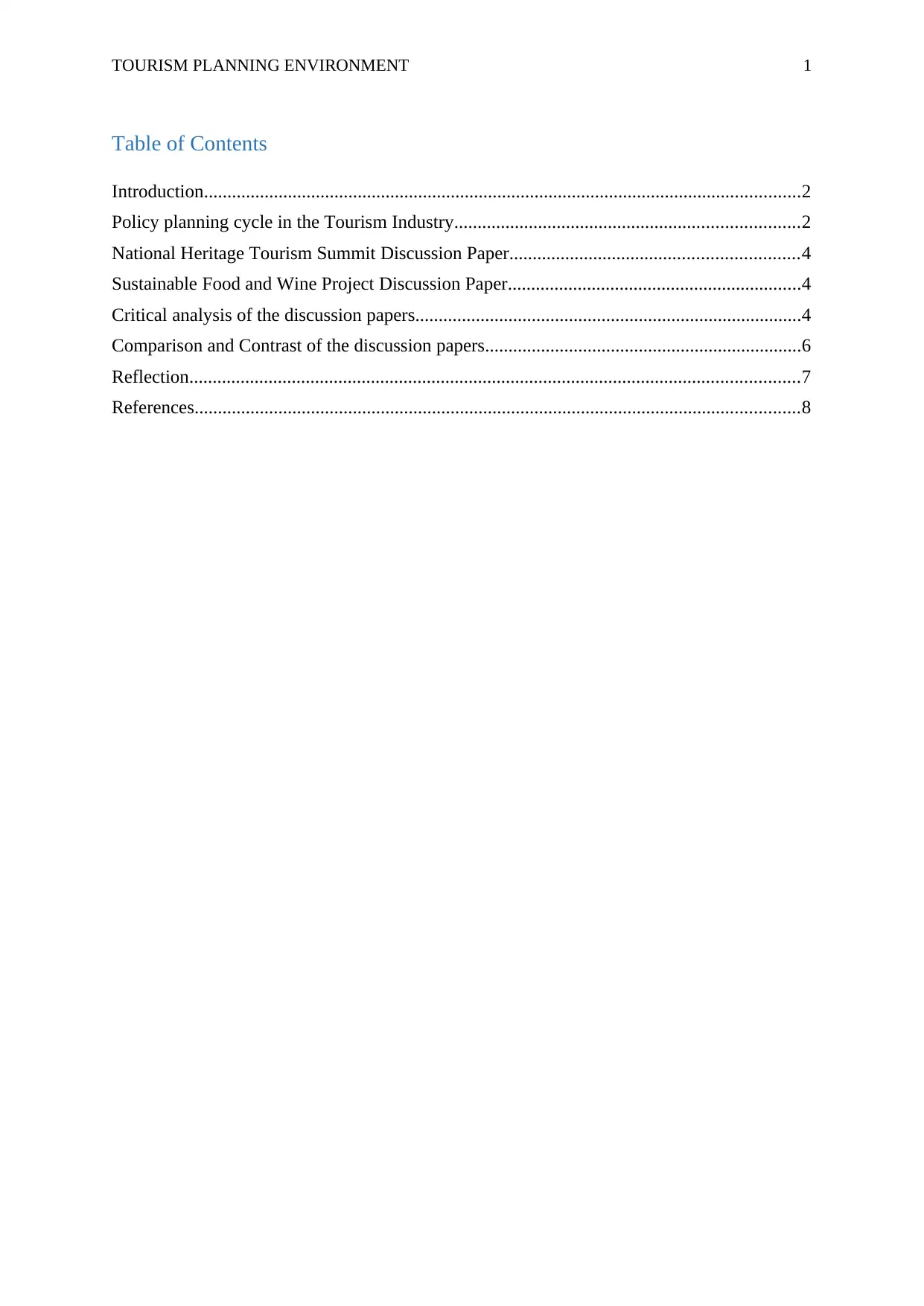
TOURISM PLANNING ENVIRONMENT 1
Table of Contents
Introduction................................................................................................................................2
Policy planning cycle in the Tourism Industry..........................................................................2
National Heritage Tourism Summit Discussion Paper..............................................................4
Sustainable Food and Wine Project Discussion Paper...............................................................4
Critical analysis of the discussion papers...................................................................................4
Comparison and Contrast of the discussion papers....................................................................6
Reflection...................................................................................................................................7
References..................................................................................................................................8
Table of Contents
Introduction................................................................................................................................2
Policy planning cycle in the Tourism Industry..........................................................................2
National Heritage Tourism Summit Discussion Paper..............................................................4
Sustainable Food and Wine Project Discussion Paper...............................................................4
Critical analysis of the discussion papers...................................................................................4
Comparison and Contrast of the discussion papers....................................................................6
Reflection...................................................................................................................................7
References..................................................................................................................................8
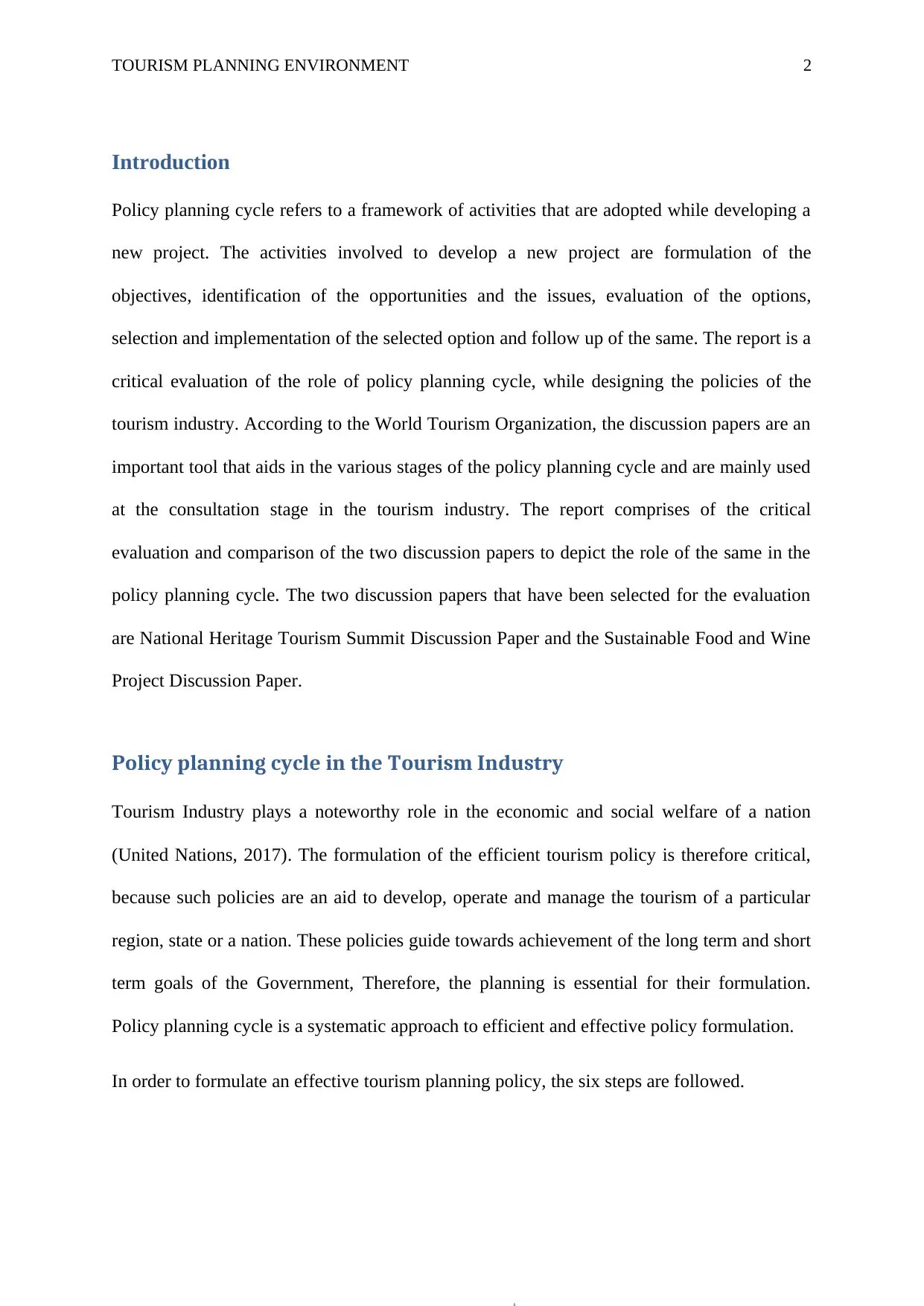
TOURISM PLANNING ENVIRONMENT 2
Introduction
Policy planning cycle refers to a framework of activities that are adopted while developing a
new project. The activities involved to develop a new project are formulation of the
objectives, identification of the opportunities and the issues, evaluation of the options,
selection and implementation of the selected option and follow up of the same. The report is a
critical evaluation of the role of policy planning cycle, while designing the policies of the
tourism industry. According to the World Tourism Organization, the discussion papers are an
important tool that aids in the various stages of the policy planning cycle and are mainly used
at the consultation stage in the tourism industry. The report comprises of the critical
evaluation and comparison of the two discussion papers to depict the role of the same in the
policy planning cycle. The two discussion papers that have been selected for the evaluation
are National Heritage Tourism Summit Discussion Paper and the Sustainable Food and Wine
Project Discussion Paper.
Policy planning cycle in the Tourism Industry
Tourism Industry plays a noteworthy role in the economic and social welfare of a nation
(United Nations, 2017). The formulation of the efficient tourism policy is therefore critical,
because such policies are an aid to develop, operate and manage the tourism of a particular
region, state or a nation. These policies guide towards achievement of the long term and short
term goals of the Government, Therefore, the planning is essential for their formulation.
Policy planning cycle is a systematic approach to efficient and effective policy formulation.
In order to formulate an effective tourism planning policy, the six steps are followed.
Introduction
Policy planning cycle refers to a framework of activities that are adopted while developing a
new project. The activities involved to develop a new project are formulation of the
objectives, identification of the opportunities and the issues, evaluation of the options,
selection and implementation of the selected option and follow up of the same. The report is a
critical evaluation of the role of policy planning cycle, while designing the policies of the
tourism industry. According to the World Tourism Organization, the discussion papers are an
important tool that aids in the various stages of the policy planning cycle and are mainly used
at the consultation stage in the tourism industry. The report comprises of the critical
evaluation and comparison of the two discussion papers to depict the role of the same in the
policy planning cycle. The two discussion papers that have been selected for the evaluation
are National Heritage Tourism Summit Discussion Paper and the Sustainable Food and Wine
Project Discussion Paper.
Policy planning cycle in the Tourism Industry
Tourism Industry plays a noteworthy role in the economic and social welfare of a nation
(United Nations, 2017). The formulation of the efficient tourism policy is therefore critical,
because such policies are an aid to develop, operate and manage the tourism of a particular
region, state or a nation. These policies guide towards achievement of the long term and short
term goals of the Government, Therefore, the planning is essential for their formulation.
Policy planning cycle is a systematic approach to efficient and effective policy formulation.
In order to formulate an effective tourism planning policy, the six steps are followed.
⊘ This is a preview!⊘
Do you want full access?
Subscribe today to unlock all pages.

Trusted by 1+ million students worldwide
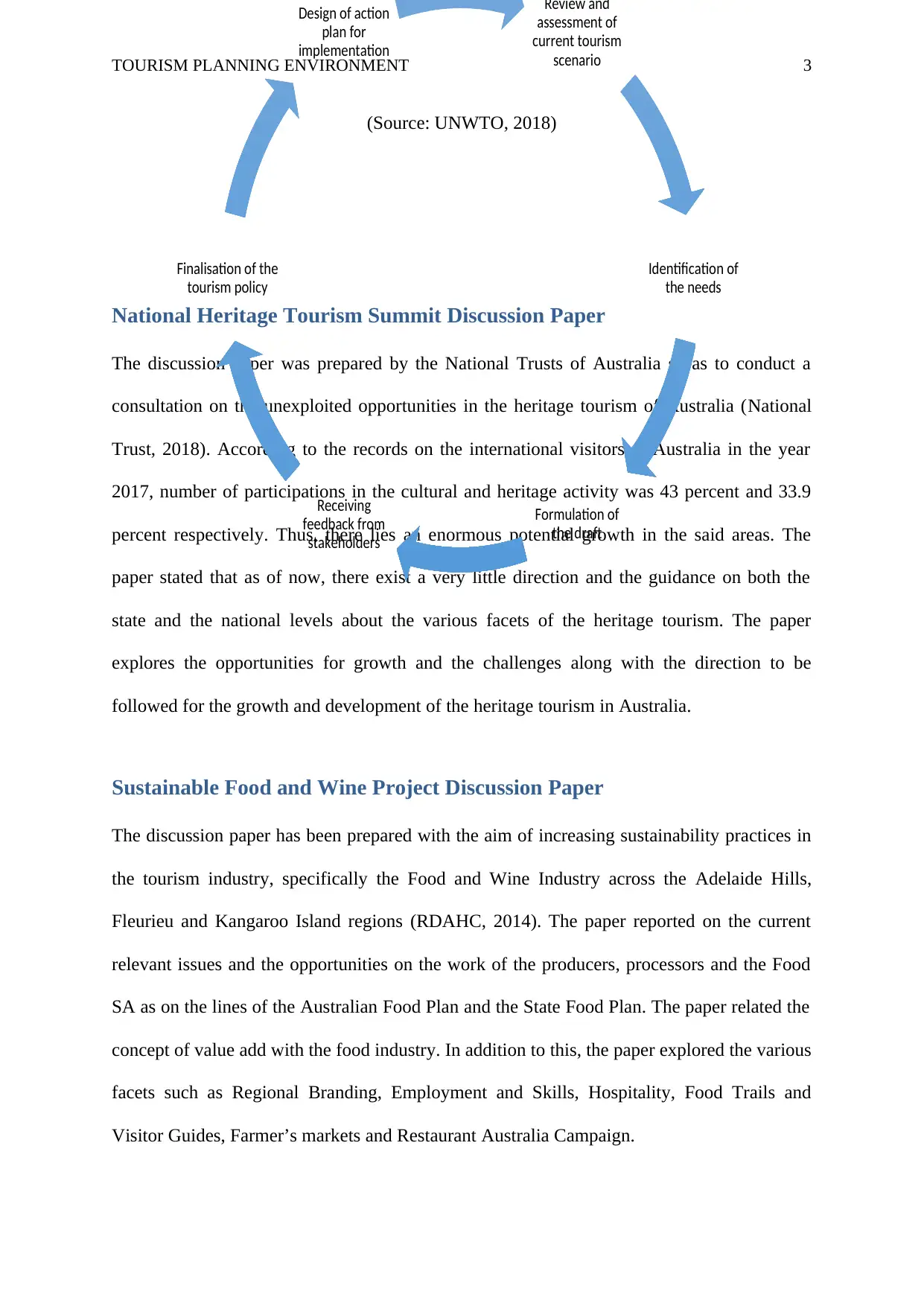
TOURISM PLANNING ENVIRONMENT 3
(Source: UNWTO, 2018)
National Heritage Tourism Summit Discussion Paper
The discussion paper was prepared by the National Trusts of Australia so as to conduct a
consultation on the unexploited opportunities in the heritage tourism of Australia (National
Trust, 2018). According to the records on the international visitors to Australia in the year
2017, number of participations in the cultural and heritage activity was 43 percent and 33.9
percent respectively. Thus, there lies an enormous potential growth in the said areas. The
paper stated that as of now, there exist a very little direction and the guidance on both the
state and the national levels about the various facets of the heritage tourism. The paper
explores the opportunities for growth and the challenges along with the direction to be
followed for the growth and development of the heritage tourism in Australia.
Sustainable Food and Wine Project Discussion Paper
The discussion paper has been prepared with the aim of increasing sustainability practices in
the tourism industry, specifically the Food and Wine Industry across the Adelaide Hills,
Fleurieu and Kangaroo Island regions (RDAHC, 2014). The paper reported on the current
relevant issues and the opportunities on the work of the producers, processors and the Food
SA as on the lines of the Australian Food Plan and the State Food Plan. The paper related the
concept of value add with the food industry. In addition to this, the paper explored the various
facets such as Regional Branding, Employment and Skills, Hospitality, Food Trails and
Visitor Guides, Farmer’s markets and Restaurant Australia Campaign.
Review and
assessment of
current tourism
scenario
Identification of
the needs
Formulation of
the draft
Receiving
feedback from
stakeholders
Finalisation of the
tourism policy
Design of action
plan for
implementation
(Source: UNWTO, 2018)
National Heritage Tourism Summit Discussion Paper
The discussion paper was prepared by the National Trusts of Australia so as to conduct a
consultation on the unexploited opportunities in the heritage tourism of Australia (National
Trust, 2018). According to the records on the international visitors to Australia in the year
2017, number of participations in the cultural and heritage activity was 43 percent and 33.9
percent respectively. Thus, there lies an enormous potential growth in the said areas. The
paper stated that as of now, there exist a very little direction and the guidance on both the
state and the national levels about the various facets of the heritage tourism. The paper
explores the opportunities for growth and the challenges along with the direction to be
followed for the growth and development of the heritage tourism in Australia.
Sustainable Food and Wine Project Discussion Paper
The discussion paper has been prepared with the aim of increasing sustainability practices in
the tourism industry, specifically the Food and Wine Industry across the Adelaide Hills,
Fleurieu and Kangaroo Island regions (RDAHC, 2014). The paper reported on the current
relevant issues and the opportunities on the work of the producers, processors and the Food
SA as on the lines of the Australian Food Plan and the State Food Plan. The paper related the
concept of value add with the food industry. In addition to this, the paper explored the various
facets such as Regional Branding, Employment and Skills, Hospitality, Food Trails and
Visitor Guides, Farmer’s markets and Restaurant Australia Campaign.
Review and
assessment of
current tourism
scenario
Identification of
the needs
Formulation of
the draft
Receiving
feedback from
stakeholders
Finalisation of the
tourism policy
Design of action
plan for
implementation
Paraphrase This Document
Need a fresh take? Get an instant paraphrase of this document with our AI Paraphraser
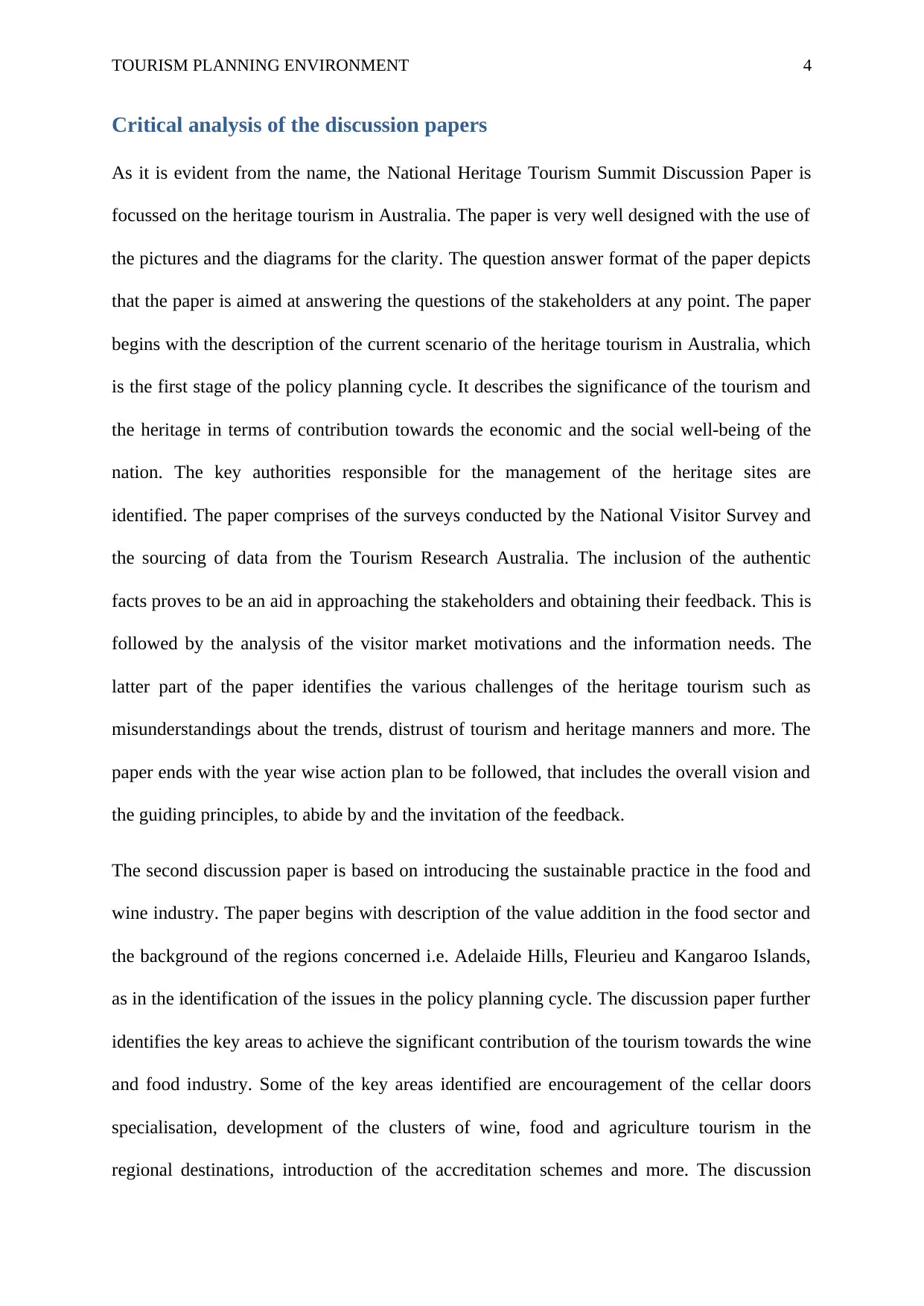
TOURISM PLANNING ENVIRONMENT 4
Critical analysis of the discussion papers
As it is evident from the name, the National Heritage Tourism Summit Discussion Paper is
focussed on the heritage tourism in Australia. The paper is very well designed with the use of
the pictures and the diagrams for the clarity. The question answer format of the paper depicts
that the paper is aimed at answering the questions of the stakeholders at any point. The paper
begins with the description of the current scenario of the heritage tourism in Australia, which
is the first stage of the policy planning cycle. It describes the significance of the tourism and
the heritage in terms of contribution towards the economic and the social well-being of the
nation. The key authorities responsible for the management of the heritage sites are
identified. The paper comprises of the surveys conducted by the National Visitor Survey and
the sourcing of data from the Tourism Research Australia. The inclusion of the authentic
facts proves to be an aid in approaching the stakeholders and obtaining their feedback. This is
followed by the analysis of the visitor market motivations and the information needs. The
latter part of the paper identifies the various challenges of the heritage tourism such as
misunderstandings about the trends, distrust of tourism and heritage manners and more. The
paper ends with the year wise action plan to be followed, that includes the overall vision and
the guiding principles, to abide by and the invitation of the feedback.
The second discussion paper is based on introducing the sustainable practice in the food and
wine industry. The paper begins with description of the value addition in the food sector and
the background of the regions concerned i.e. Adelaide Hills, Fleurieu and Kangaroo Islands,
as in the identification of the issues in the policy planning cycle. The discussion paper further
identifies the key areas to achieve the significant contribution of the tourism towards the wine
and food industry. Some of the key areas identified are encouragement of the cellar doors
specialisation, development of the clusters of wine, food and agriculture tourism in the
regional destinations, introduction of the accreditation schemes and more. The discussion
Critical analysis of the discussion papers
As it is evident from the name, the National Heritage Tourism Summit Discussion Paper is
focussed on the heritage tourism in Australia. The paper is very well designed with the use of
the pictures and the diagrams for the clarity. The question answer format of the paper depicts
that the paper is aimed at answering the questions of the stakeholders at any point. The paper
begins with the description of the current scenario of the heritage tourism in Australia, which
is the first stage of the policy planning cycle. It describes the significance of the tourism and
the heritage in terms of contribution towards the economic and the social well-being of the
nation. The key authorities responsible for the management of the heritage sites are
identified. The paper comprises of the surveys conducted by the National Visitor Survey and
the sourcing of data from the Tourism Research Australia. The inclusion of the authentic
facts proves to be an aid in approaching the stakeholders and obtaining their feedback. This is
followed by the analysis of the visitor market motivations and the information needs. The
latter part of the paper identifies the various challenges of the heritage tourism such as
misunderstandings about the trends, distrust of tourism and heritage manners and more. The
paper ends with the year wise action plan to be followed, that includes the overall vision and
the guiding principles, to abide by and the invitation of the feedback.
The second discussion paper is based on introducing the sustainable practice in the food and
wine industry. The paper begins with description of the value addition in the food sector and
the background of the regions concerned i.e. Adelaide Hills, Fleurieu and Kangaroo Islands,
as in the identification of the issues in the policy planning cycle. The discussion paper further
identifies the key areas to achieve the significant contribution of the tourism towards the wine
and food industry. Some of the key areas identified are encouragement of the cellar doors
specialisation, development of the clusters of wine, food and agriculture tourism in the
regional destinations, introduction of the accreditation schemes and more. The discussion
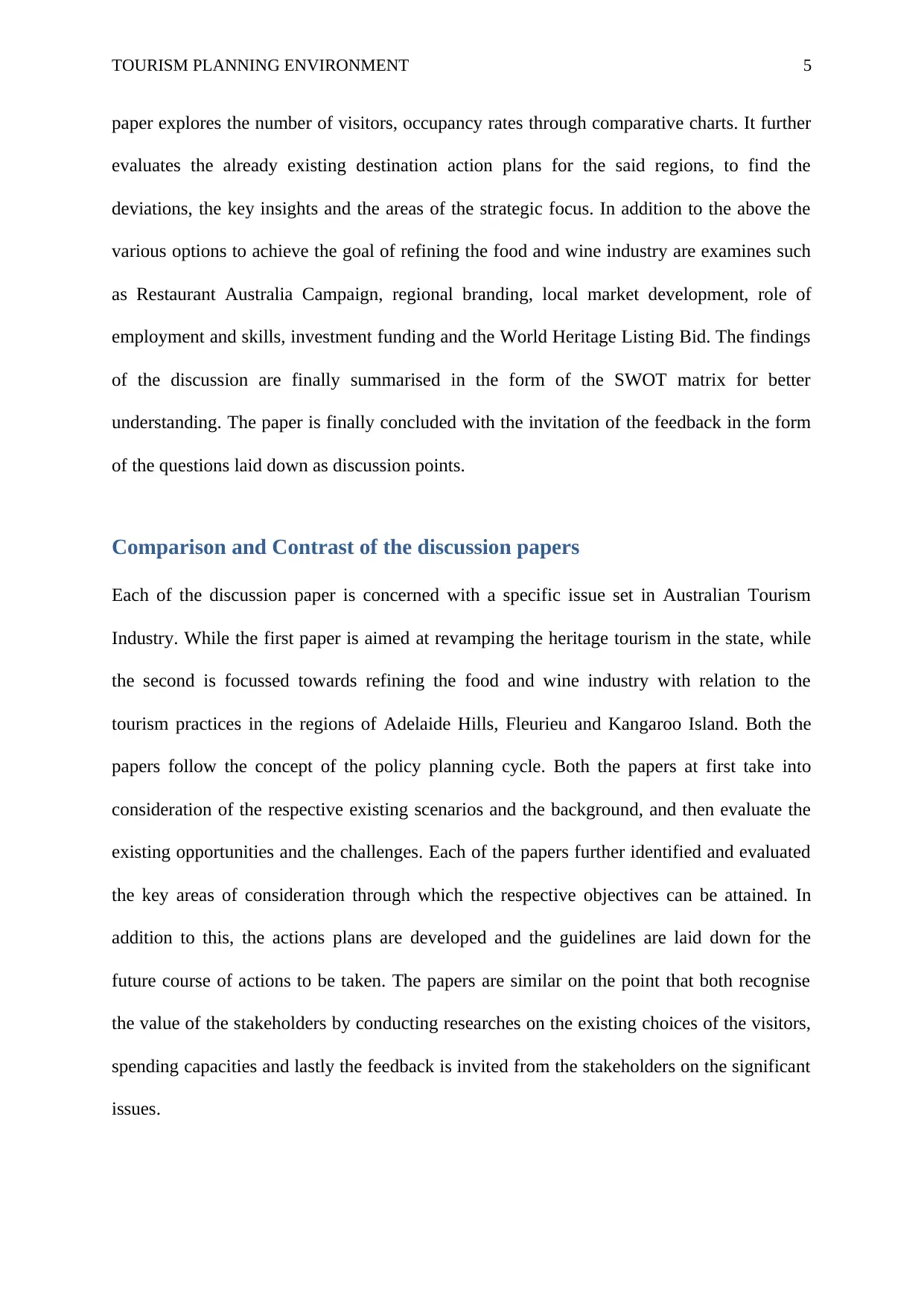
TOURISM PLANNING ENVIRONMENT 5
paper explores the number of visitors, occupancy rates through comparative charts. It further
evaluates the already existing destination action plans for the said regions, to find the
deviations, the key insights and the areas of the strategic focus. In addition to the above the
various options to achieve the goal of refining the food and wine industry are examines such
as Restaurant Australia Campaign, regional branding, local market development, role of
employment and skills, investment funding and the World Heritage Listing Bid. The findings
of the discussion are finally summarised in the form of the SWOT matrix for better
understanding. The paper is finally concluded with the invitation of the feedback in the form
of the questions laid down as discussion points.
Comparison and Contrast of the discussion papers
Each of the discussion paper is concerned with a specific issue set in Australian Tourism
Industry. While the first paper is aimed at revamping the heritage tourism in the state, while
the second is focussed towards refining the food and wine industry with relation to the
tourism practices in the regions of Adelaide Hills, Fleurieu and Kangaroo Island. Both the
papers follow the concept of the policy planning cycle. Both the papers at first take into
consideration of the respective existing scenarios and the background, and then evaluate the
existing opportunities and the challenges. Each of the papers further identified and evaluated
the key areas of consideration through which the respective objectives can be attained. In
addition to this, the actions plans are developed and the guidelines are laid down for the
future course of actions to be taken. The papers are similar on the point that both recognise
the value of the stakeholders by conducting researches on the existing choices of the visitors,
spending capacities and lastly the feedback is invited from the stakeholders on the significant
issues.
paper explores the number of visitors, occupancy rates through comparative charts. It further
evaluates the already existing destination action plans for the said regions, to find the
deviations, the key insights and the areas of the strategic focus. In addition to the above the
various options to achieve the goal of refining the food and wine industry are examines such
as Restaurant Australia Campaign, regional branding, local market development, role of
employment and skills, investment funding and the World Heritage Listing Bid. The findings
of the discussion are finally summarised in the form of the SWOT matrix for better
understanding. The paper is finally concluded with the invitation of the feedback in the form
of the questions laid down as discussion points.
Comparison and Contrast of the discussion papers
Each of the discussion paper is concerned with a specific issue set in Australian Tourism
Industry. While the first paper is aimed at revamping the heritage tourism in the state, while
the second is focussed towards refining the food and wine industry with relation to the
tourism practices in the regions of Adelaide Hills, Fleurieu and Kangaroo Island. Both the
papers follow the concept of the policy planning cycle. Both the papers at first take into
consideration of the respective existing scenarios and the background, and then evaluate the
existing opportunities and the challenges. Each of the papers further identified and evaluated
the key areas of consideration through which the respective objectives can be attained. In
addition to this, the actions plans are developed and the guidelines are laid down for the
future course of actions to be taken. The papers are similar on the point that both recognise
the value of the stakeholders by conducting researches on the existing choices of the visitors,
spending capacities and lastly the feedback is invited from the stakeholders on the significant
issues.
⊘ This is a preview!⊘
Do you want full access?
Subscribe today to unlock all pages.

Trusted by 1+ million students worldwide
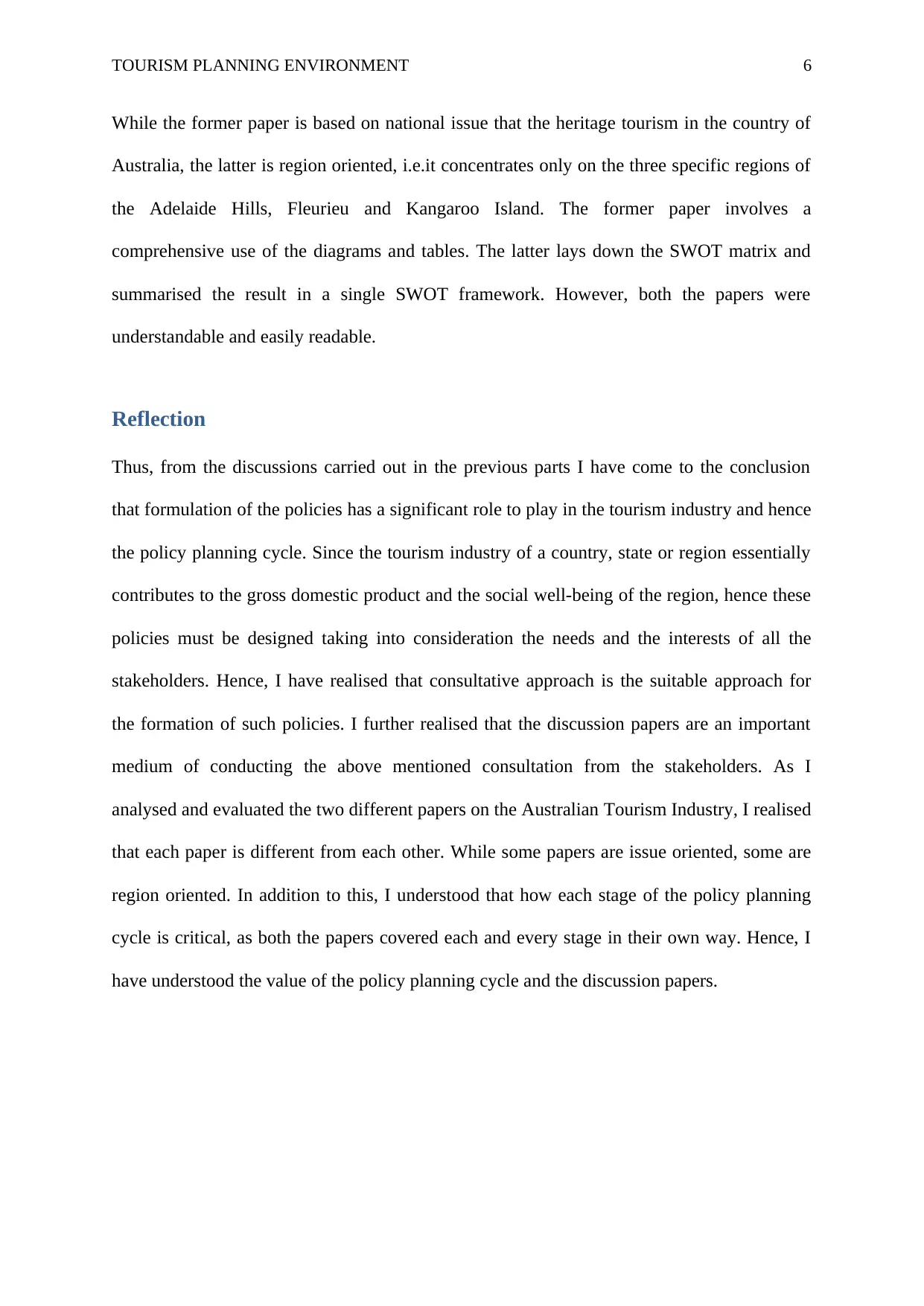
TOURISM PLANNING ENVIRONMENT 6
While the former paper is based on national issue that the heritage tourism in the country of
Australia, the latter is region oriented, i.e.it concentrates only on the three specific regions of
the Adelaide Hills, Fleurieu and Kangaroo Island. The former paper involves a
comprehensive use of the diagrams and tables. The latter lays down the SWOT matrix and
summarised the result in a single SWOT framework. However, both the papers were
understandable and easily readable.
Reflection
Thus, from the discussions carried out in the previous parts I have come to the conclusion
that formulation of the policies has a significant role to play in the tourism industry and hence
the policy planning cycle. Since the tourism industry of a country, state or region essentially
contributes to the gross domestic product and the social well-being of the region, hence these
policies must be designed taking into consideration the needs and the interests of all the
stakeholders. Hence, I have realised that consultative approach is the suitable approach for
the formation of such policies. I further realised that the discussion papers are an important
medium of conducting the above mentioned consultation from the stakeholders. As I
analysed and evaluated the two different papers on the Australian Tourism Industry, I realised
that each paper is different from each other. While some papers are issue oriented, some are
region oriented. In addition to this, I understood that how each stage of the policy planning
cycle is critical, as both the papers covered each and every stage in their own way. Hence, I
have understood the value of the policy planning cycle and the discussion papers.
While the former paper is based on national issue that the heritage tourism in the country of
Australia, the latter is region oriented, i.e.it concentrates only on the three specific regions of
the Adelaide Hills, Fleurieu and Kangaroo Island. The former paper involves a
comprehensive use of the diagrams and tables. The latter lays down the SWOT matrix and
summarised the result in a single SWOT framework. However, both the papers were
understandable and easily readable.
Reflection
Thus, from the discussions carried out in the previous parts I have come to the conclusion
that formulation of the policies has a significant role to play in the tourism industry and hence
the policy planning cycle. Since the tourism industry of a country, state or region essentially
contributes to the gross domestic product and the social well-being of the region, hence these
policies must be designed taking into consideration the needs and the interests of all the
stakeholders. Hence, I have realised that consultative approach is the suitable approach for
the formation of such policies. I further realised that the discussion papers are an important
medium of conducting the above mentioned consultation from the stakeholders. As I
analysed and evaluated the two different papers on the Australian Tourism Industry, I realised
that each paper is different from each other. While some papers are issue oriented, some are
region oriented. In addition to this, I understood that how each stage of the policy planning
cycle is critical, as both the papers covered each and every stage in their own way. Hence, I
have understood the value of the policy planning cycle and the discussion papers.
Paraphrase This Document
Need a fresh take? Get an instant paraphrase of this document with our AI Paraphraser
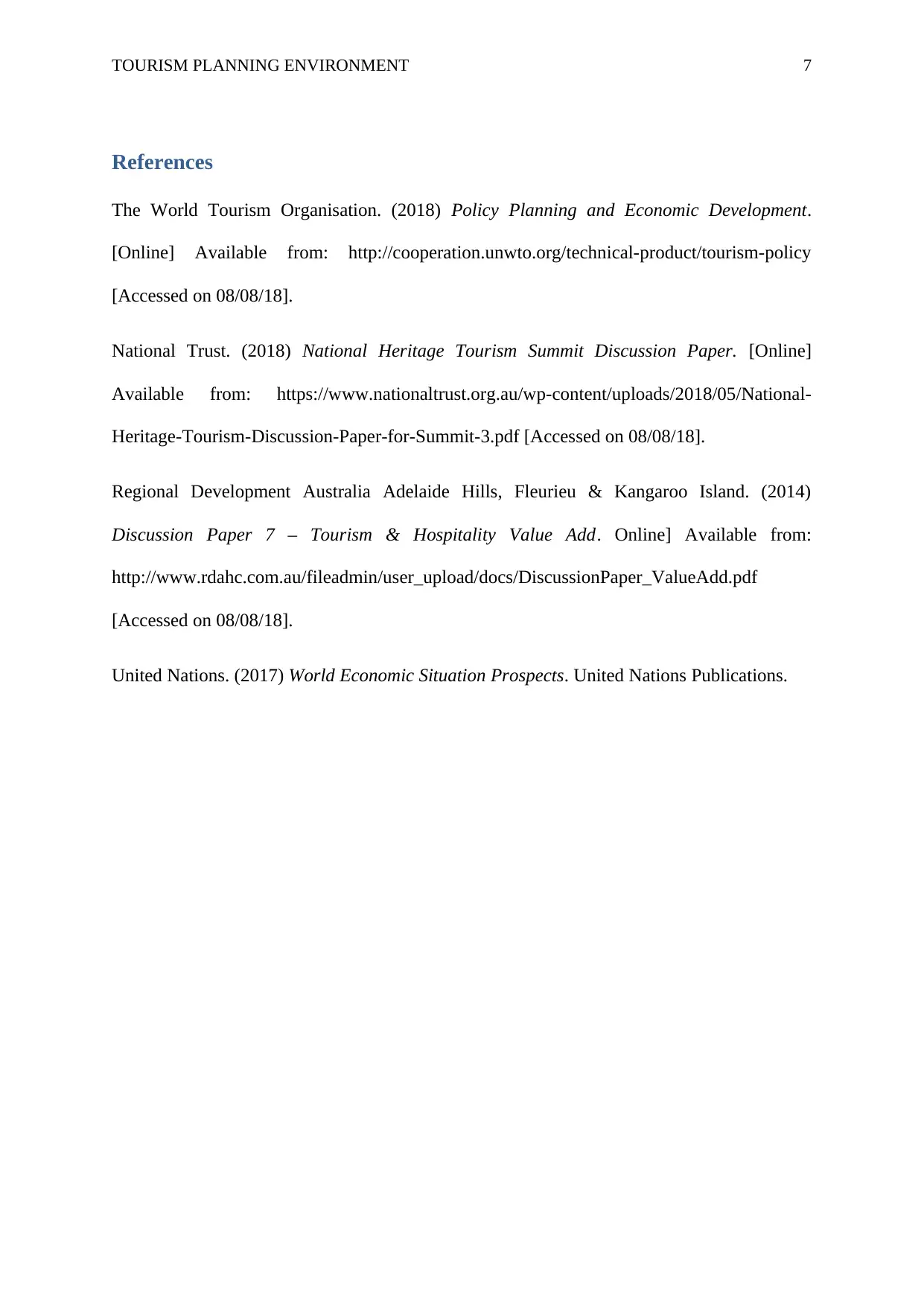
TOURISM PLANNING ENVIRONMENT 7
References
The World Tourism Organisation. (2018) Policy Planning and Economic Development.
[Online] Available from: http://cooperation.unwto.org/technical-product/tourism-policy
[Accessed on 08/08/18].
National Trust. (2018) National Heritage Tourism Summit Discussion Paper. [Online]
Available from: https://www.nationaltrust.org.au/wp-content/uploads/2018/05/National-
Heritage-Tourism-Discussion-Paper-for-Summit-3.pdf [Accessed on 08/08/18].
Regional Development Australia Adelaide Hills, Fleurieu & Kangaroo Island. (2014)
Discussion Paper 7 – Tourism & Hospitality Value Add. Online] Available from:
http://www.rdahc.com.au/fileadmin/user_upload/docs/DiscussionPaper_ValueAdd.pdf
[Accessed on 08/08/18].
United Nations. (2017) World Economic Situation Prospects. United Nations Publications.
References
The World Tourism Organisation. (2018) Policy Planning and Economic Development.
[Online] Available from: http://cooperation.unwto.org/technical-product/tourism-policy
[Accessed on 08/08/18].
National Trust. (2018) National Heritage Tourism Summit Discussion Paper. [Online]
Available from: https://www.nationaltrust.org.au/wp-content/uploads/2018/05/National-
Heritage-Tourism-Discussion-Paper-for-Summit-3.pdf [Accessed on 08/08/18].
Regional Development Australia Adelaide Hills, Fleurieu & Kangaroo Island. (2014)
Discussion Paper 7 – Tourism & Hospitality Value Add. Online] Available from:
http://www.rdahc.com.au/fileadmin/user_upload/docs/DiscussionPaper_ValueAdd.pdf
[Accessed on 08/08/18].
United Nations. (2017) World Economic Situation Prospects. United Nations Publications.
1 out of 8
Related Documents
Your All-in-One AI-Powered Toolkit for Academic Success.
+13062052269
info@desklib.com
Available 24*7 on WhatsApp / Email
![[object Object]](/_next/static/media/star-bottom.7253800d.svg)
Unlock your academic potential
Copyright © 2020–2025 A2Z Services. All Rights Reserved. Developed and managed by ZUCOL.





